Abstract
The host-parasite interaction in Pneumocystis carinii pneumonia is poorly understood. In recent years, two major groups of P. carinii antigens have been identified. One class of antigens is characterized by a broad band of immunoreactivity between 45 and 55 kDa in P. carinii derived from rats. This antigen complex is the P. carinii antigen most commonly found in respiratory tract specimens and most frequently recognized by the host immune response. The availability of a recombinant antigen has permitted studies focusing on the cellular and humoral responses to a single antigen within this class, p55. In this study, we have demonstrated that the p55 antigen elicits a cell-mediated immune response in animals previously exposed to P. carinii. Under conditions of natural exposure, the 5' portion of the molecule, p55(1-200), appears immunologically silent, failing to elicit lymphocyte proliferation or cytokine secretion. Following active immunization, the 5' portion is capable of stimulating lymphocyte proliferation. The 3' portion, p55(268-414), has at least one immunodominant region which contains a 7-amino-acid repeat motif. The cells responding to p55 include a CD4+ T cell which secretes a Th1 cytokine pattern. A detailed understanding of the host-parasite interaction will facilitate the development of immunoprophylaxis and immunotherapy for P. carinii infection.
Full text
PDF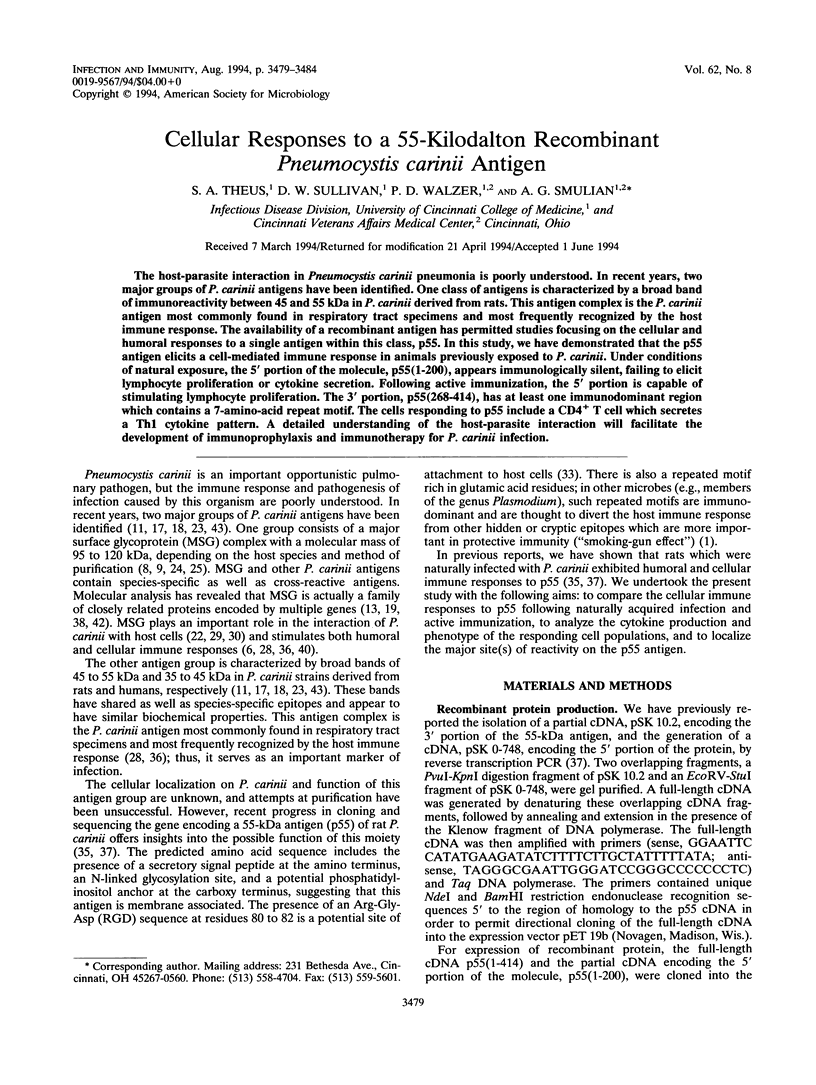
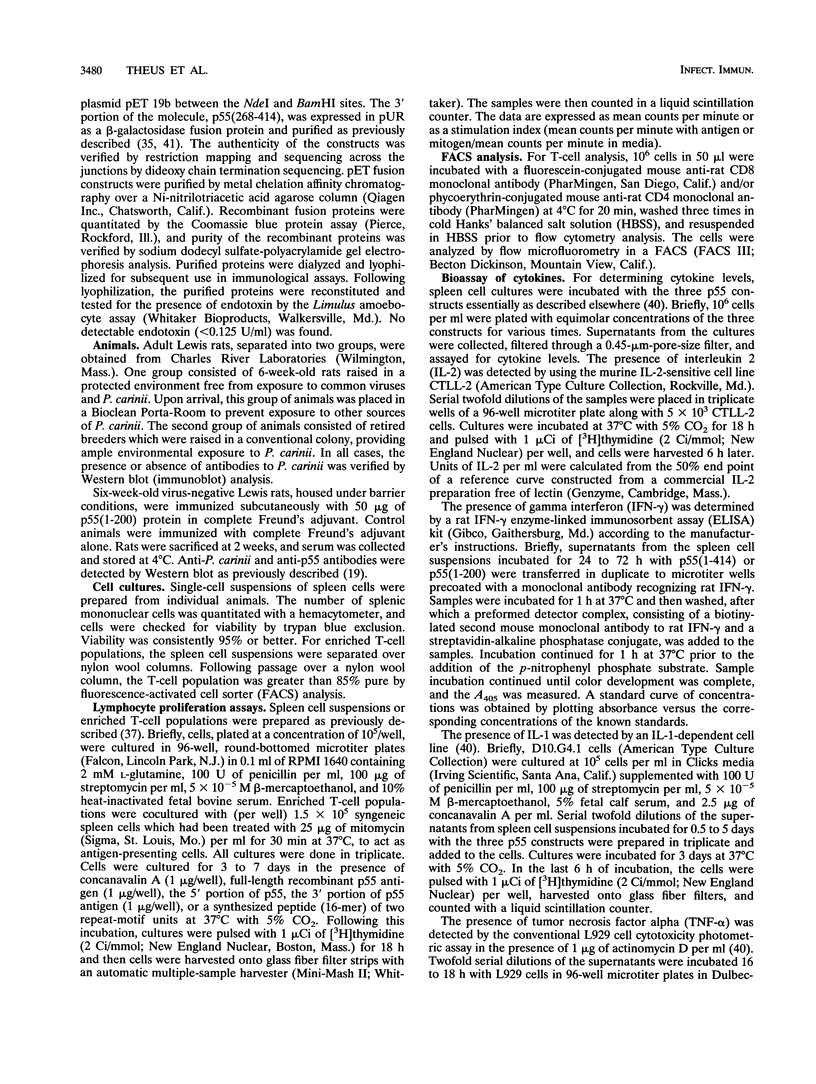
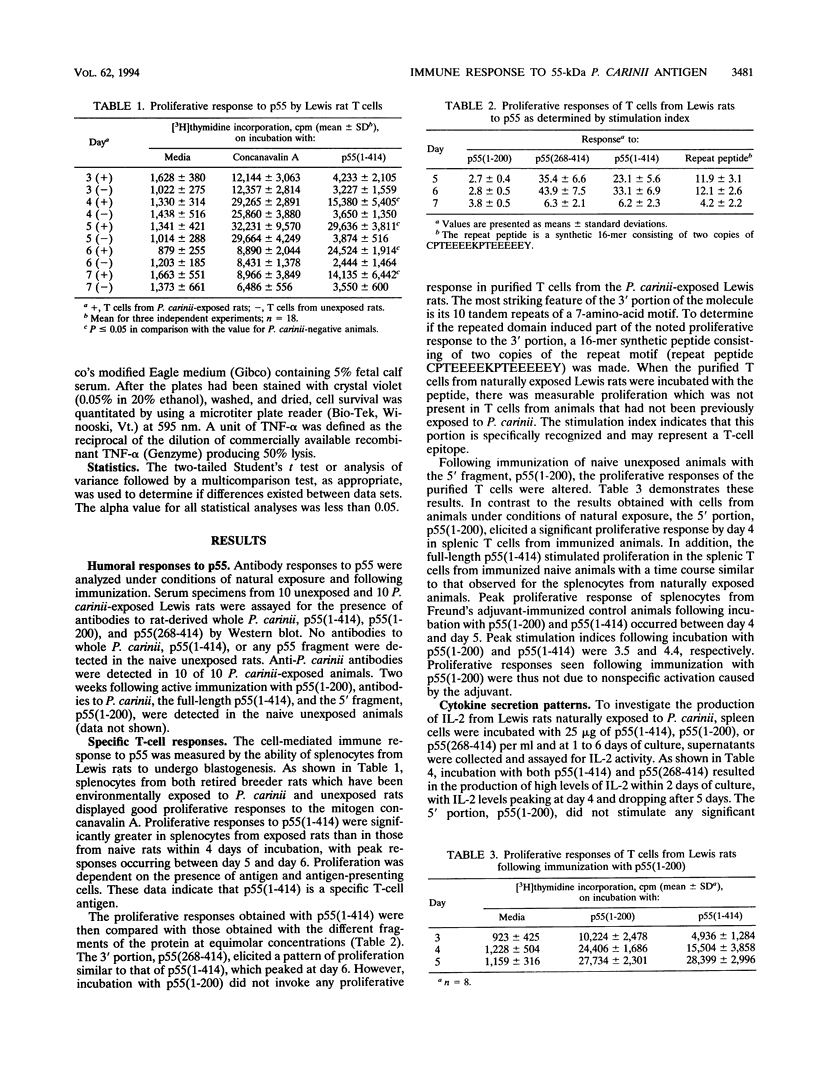
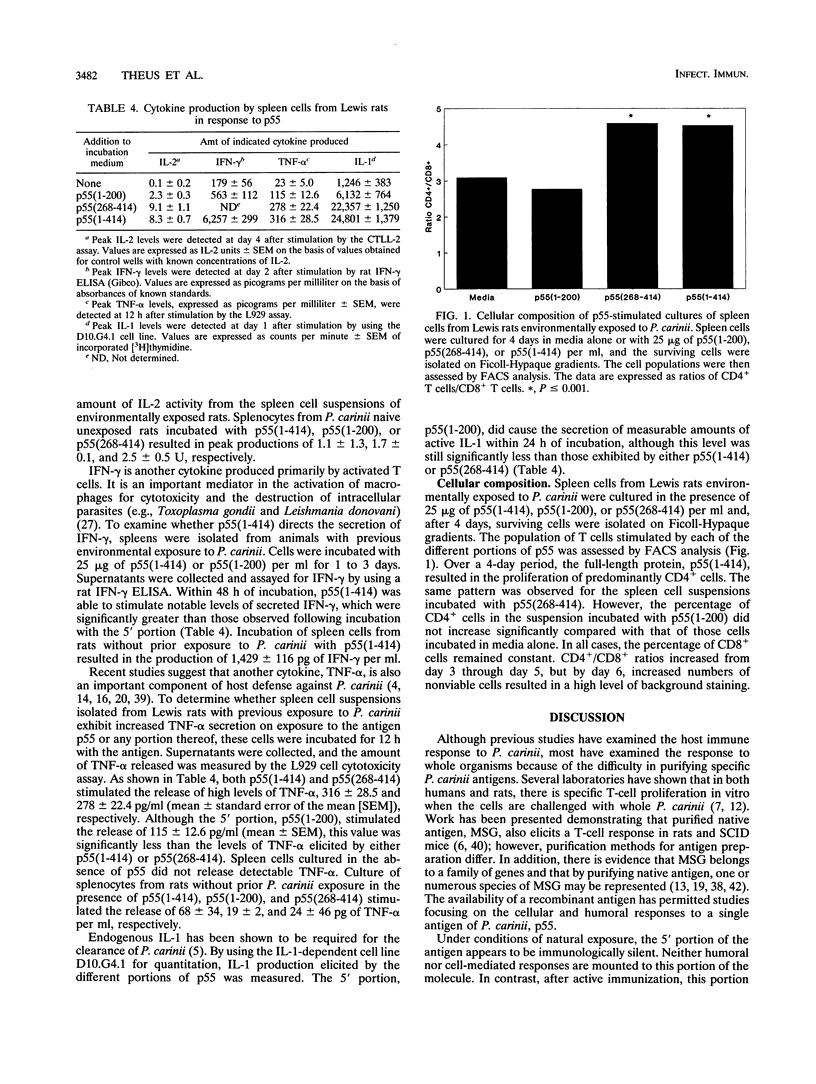
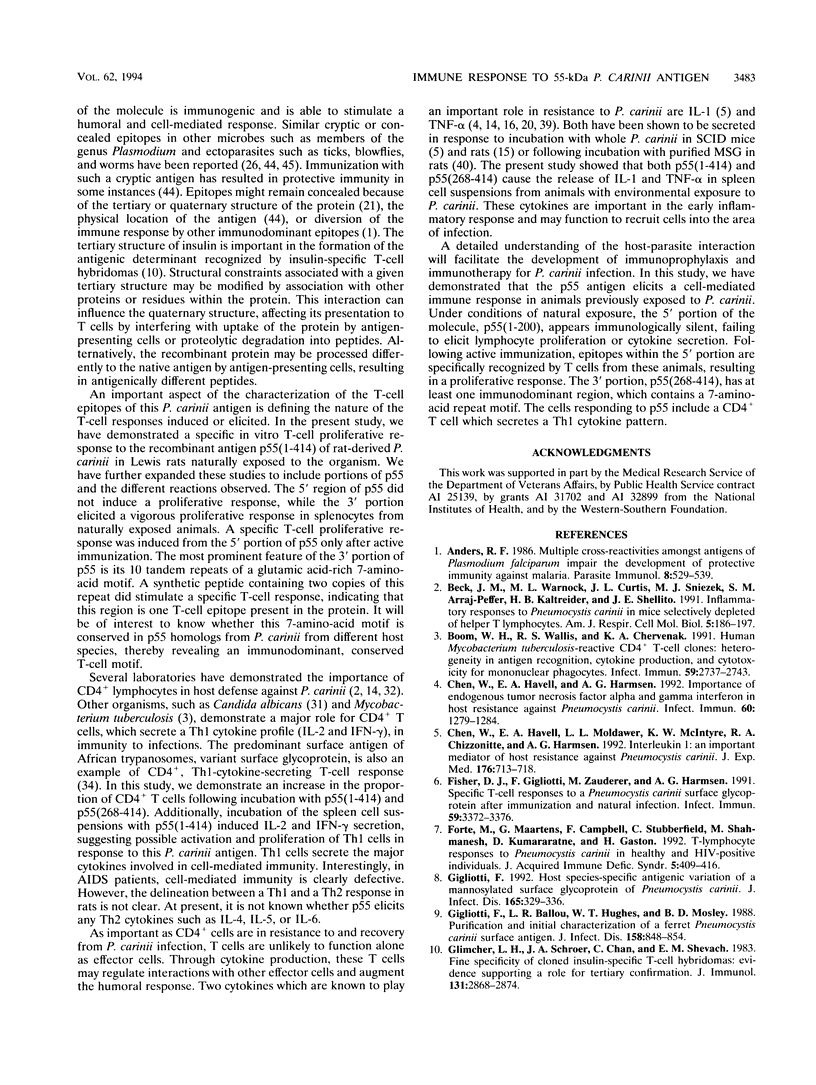
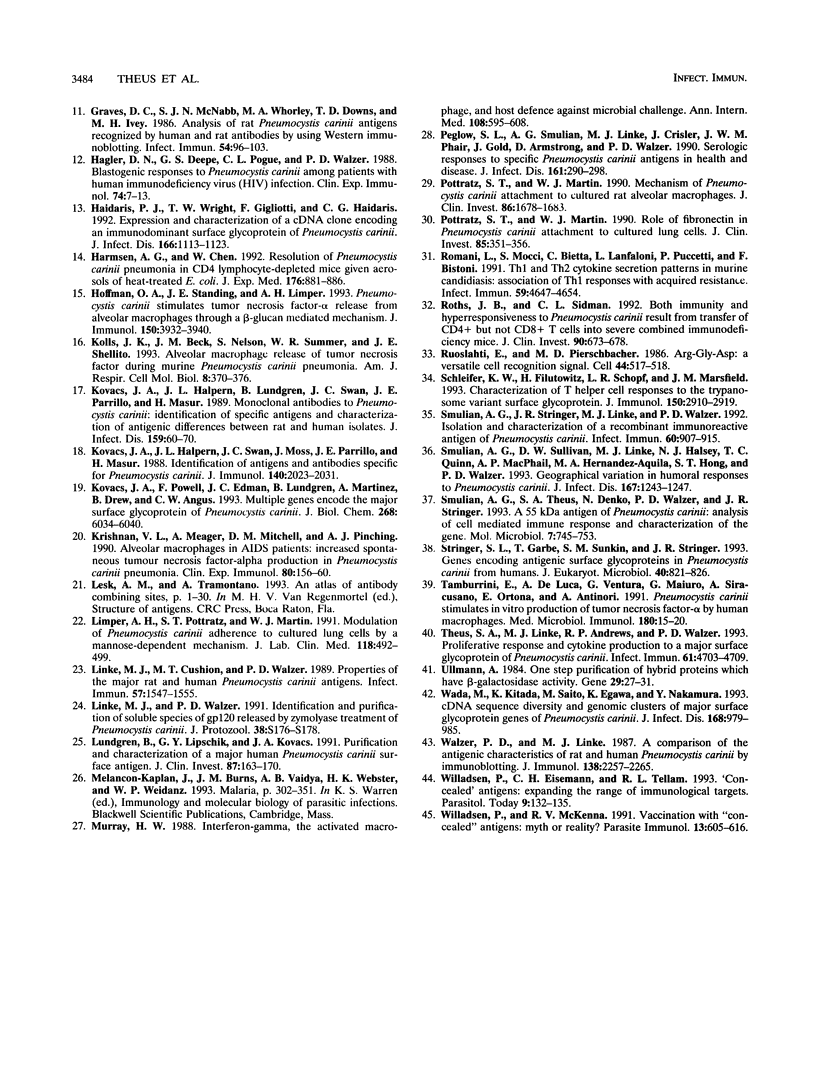
Selected References
These references are in PubMed. This may not be the complete list of references from this article.
- Anders R. F. Multiple cross-reactivities amongst antigens of Plasmodium falciparum impair the development of protective immunity against malaria. Parasite Immunol. 1986 Nov;8(6):529–539. doi: 10.1111/j.1365-3024.1986.tb00867.x. [DOI] [PubMed] [Google Scholar]
- Beck J. M., Warnock M. L., Curtis J. L., Sniezek M. J., Arraj-Peffer S. M., Kaltreider H. B., Shellito J. E. Inflammatory responses to Pneumocystis carinii in mice selectively depleted of helper T lymphocytes. Am J Respir Cell Mol Biol. 1991 Aug;5(2):186–197. doi: 10.1165/ajrcmb/5.2.186. [DOI] [PubMed] [Google Scholar]
- Boom W. H., Wallis R. S., Chervenak K. A. Human Mycobacterium tuberculosis-reactive CD4+ T-cell clones: heterogeneity in antigen recognition, cytokine production, and cytotoxicity for mononuclear phagocytes. Infect Immun. 1991 Aug;59(8):2737–2743. doi: 10.1128/iai.59.8.2737-2743.1991. [DOI] [PMC free article] [PubMed] [Google Scholar]
- Chen W., Havell E. A., Harmsen A. G. Importance of endogenous tumor necrosis factor alpha and gamma interferon in host resistance against Pneumocystis carinii infection. Infect Immun. 1992 Apr;60(4):1279–1284. doi: 10.1128/iai.60.4.1279-1284.1992. [DOI] [PMC free article] [PubMed] [Google Scholar]
- Chen W., Havell E. A., Moldawer L. L., McIntyre K. W., Chizzonite R. A., Harmsen A. G. Interleukin 1: an important mediator of host resistance against Pneumocystis carinii. J Exp Med. 1992 Sep 1;176(3):713–718. doi: 10.1084/jem.176.3.713. [DOI] [PMC free article] [PubMed] [Google Scholar]
- Fisher D. J., Gigliotti F., Zauderer M., Harmsen A. G. Specific T-cell response to a Pneumocystis carinii surface glycoprotein (gp120) after immunization and natural infection. Infect Immun. 1991 Oct;59(10):3372–3376. doi: 10.1128/iai.59.10.3372-3376.1991. [DOI] [PMC free article] [PubMed] [Google Scholar]
- Forte M., Maartens G., Campbell F., Stubberfield C., Shahmanesh M., Kumararatne D., Gaston H. T-lymphocyte responses to Pneumocystis carinii in healthy and HIV-positive individuals. J Acquir Immune Defic Syndr. 1992;5(4):409–416. [PubMed] [Google Scholar]
- Gigliotti F., Ballou L. R., Hughes W. T., Mosley B. D. Purification and initial characterization of a ferret Pneumocystis carinii surface antigen. J Infect Dis. 1988 Oct;158(4):848–854. doi: 10.1093/infdis/158.4.848. [DOI] [PubMed] [Google Scholar]
- Gigliotti F. Host species-specific antigenic variation of a mannosylated surface glycoprotein of Pneumocystis carinii. J Infect Dis. 1992 Feb;165(2):329–336. doi: 10.1093/infdis/165.2.329. [DOI] [PubMed] [Google Scholar]
- Glimcher L. H., Schroer J. A., Chan C., Shevach E. M. Fine specificity of cloned insulin-specific T cell hybridomas: evidence supporting a role for tertiary conformation. J Immunol. 1983 Dec;131(6):2868–2874. [PubMed] [Google Scholar]
- Graves D. C., McNabb S. J., Worley M. A., Downs T. D., Ivey M. H. Analyses of rat Pneumocystis carinii antigens recognized by human and rat antibodies by using western immunoblotting. Infect Immun. 1986 Oct;54(1):96–103. doi: 10.1128/iai.54.1.96-103.1986. [DOI] [PMC free article] [PubMed] [Google Scholar]
- Hagler D. N., Deepe G. S., Pogue C. L., Walzer P. D. Blastogenic responses to Pneumocystis carinii among patients with human immunodeficiency (HIV) infection. Clin Exp Immunol. 1988 Oct;74(1):7–13. [PMC free article] [PubMed] [Google Scholar]
- Haidaris P. J., Wright T. W., Gigliotti F., Haidaris C. G. Expression and characterization of a cDNA clone encoding an immunodominant surface glycoprotein of Pneumocystis carinii. J Infect Dis. 1992 Nov;166(5):1113–1123. doi: 10.1093/infdis/166.5.1113. [DOI] [PubMed] [Google Scholar]
- Harmsen A. G., Chen W. Resolution of Pneumocystis carinii pneumonia in CD4+ lymphocyte-depleted mice given aerosols of heat-treated Escherichia coli. J Exp Med. 1992 Sep 1;176(3):881–886. doi: 10.1084/jem.176.3.881. [DOI] [PMC free article] [PubMed] [Google Scholar]
- Hoffman O. A., Standing J. E., Limper A. H. Pneumocystis carinii stimulates tumor necrosis factor-alpha release from alveolar macrophages through a beta-glucan-mediated mechanism. J Immunol. 1993 May 1;150(9):3932–3940. [PubMed] [Google Scholar]
- Kolls J. K., Beck J. M., Nelson S., Summer W. R., Shellito J. Alveolar macrophage release of tumor necrosis factor during murine Pneumocystis carinii pneumonia. Am J Respir Cell Mol Biol. 1993 Apr;8(4):370–376. doi: 10.1165/ajrcmb/8.4.370. [DOI] [PubMed] [Google Scholar]
- Kovacs J. A., Halpern J. L., Lundgren B., Swan J. C., Parrillo J. E., Masur H. Monoclonal antibodies to Pneumocystis carinii: identification of specific antigens and characterization of antigenic differences between rat and human isolates. J Infect Dis. 1989 Jan;159(1):60–70. doi: 10.1093/infdis/159.1.60. [DOI] [PubMed] [Google Scholar]
- Kovacs J. A., Halpern J. L., Swan J. C., Moss J., Parrillo J. E., Masur H. Identification of antigens and antibodies specific for Pneumocystis carinii. J Immunol. 1988 Mar 15;140(6):2023–2031. [PubMed] [Google Scholar]
- Kovacs J. A., Powell F., Edman J. C., Lundgren B., Martinez A., Drew B., Angus C. W. Multiple genes encode the major surface glycoprotein of Pneumocystis carinii. J Biol Chem. 1993 Mar 15;268(8):6034–6040. [PubMed] [Google Scholar]
- Krishnan V. L., Meager A., Mitchell D. M., Pinching A. J. Alveolar macrophages in AIDS patients: increased spontaneous tumour necrosis factor-alpha production in Pneumocystis carinii pneumonia. Clin Exp Immunol. 1990 May;80(2):156–160. doi: 10.1111/j.1365-2249.1990.tb05225.x. [DOI] [PMC free article] [PubMed] [Google Scholar]
- Limper A. H., Pottratz S. T., Martin W. J., 2nd Modulation of Pneumocystis carinii adherence to cultured lung cells by a mannose-dependent mechanism. J Lab Clin Med. 1991 Nov;118(5):492–499. [PubMed] [Google Scholar]
- Linke M. J., Cushion M. T., Walzer P. D. Properties of the major antigens of rat and human Pneumocystis carinii. Infect Immun. 1989 May;57(5):1547–1555. doi: 10.1128/iai.57.5.1547-1555.1989. [DOI] [PMC free article] [PubMed] [Google Scholar]
- Lundgren B., Lipschik G. Y., Kovacs J. A. Purification and characterization of a major human Pneumocystis carinii surface antigen. J Clin Invest. 1991 Jan;87(1):163–170. doi: 10.1172/JCI114966. [DOI] [PMC free article] [PubMed] [Google Scholar]
- Murray H. W. Interferon-gamma, the activated macrophage, and host defense against microbial challenge. Ann Intern Med. 1988 Apr;108(4):595–608. doi: 10.7326/0003-4819-108-4-595. [DOI] [PubMed] [Google Scholar]
- Pottratz S. T., Martin W. J., 2nd Mechanism of Pneumocystis carinii attachment to cultured rat alveolar macrophages. J Clin Invest. 1990 Nov;86(5):1678–1683. doi: 10.1172/JCI114891. [DOI] [PMC free article] [PubMed] [Google Scholar]
- Pottratz S. T., Martin W. J., 2nd Role of fibronectin in Pneumocystis carinii attachment to cultured lung cells. J Clin Invest. 1990 Feb;85(2):351–356. doi: 10.1172/JCI114445. [DOI] [PMC free article] [PubMed] [Google Scholar]
- Romani L., Mocci S., Bietta C., Lanfaloni L., Puccetti P., Bistoni F. Th1 and Th2 cytokine secretion patterns in murine candidiasis: association of Th1 responses with acquired resistance. Infect Immun. 1991 Dec;59(12):4647–4654. doi: 10.1128/iai.59.12.4647-4654.1991. [DOI] [PMC free article] [PubMed] [Google Scholar]
- Roths J. B., Sidman C. L. Both immunity and hyperresponsiveness to Pneumocystis carinii result from transfer of CD4+ but not CD8+ T cells into severe combined immunodeficiency mice. J Clin Invest. 1992 Aug;90(2):673–678. doi: 10.1172/JCI115910. [DOI] [PMC free article] [PubMed] [Google Scholar]
- Ruoslahti E., Pierschbacher M. D. Arg-Gly-Asp: a versatile cell recognition signal. Cell. 1986 Feb 28;44(4):517–518. doi: 10.1016/0092-8674(86)90259-x. [DOI] [PubMed] [Google Scholar]
- Schleifer K. W., Filutowicz H., Schopf L. R., Mansfield J. M. Characterization of T helper cell responses to the trypanosome variant surface glycoprotein. J Immunol. 1993 Apr 1;150(7):2910–2919. [PubMed] [Google Scholar]
- Smulian A. G., Stringer J. R., Linke M. J., Walzer P. D. Isolation and characterization of a recombinant antigen of Pneumocystis carinii. Infect Immun. 1992 Mar;60(3):907–915. doi: 10.1128/iai.60.3.907-915.1992. [DOI] [PMC free article] [PubMed] [Google Scholar]
- Smulian A. G., Sullivan D. W., Linke M. J., Halsey N. A., Quinn T. C., MacPhail A. P., Hernandez-Avila M. A., Hong S. T., Walzer P. D. Geographic variation in the humoral response to Pneumocystis carinii. J Infect Dis. 1993 May;167(5):1243–1247. doi: 10.1093/infdis/167.5.1243. [DOI] [PubMed] [Google Scholar]
- Smulian A. G., Theus S. A., Denko N., Walzer P. D., Stringer J. R. A 55 kDa antigen of Pneumocystis carinii: analysis of the cellular immune response and characterization of the gene. Mol Microbiol. 1993 Mar;7(5):745–753. doi: 10.1111/j.1365-2958.1993.tb01165.x. [DOI] [PubMed] [Google Scholar]
- Stringer S. L., Garbe T., Sunkin S. M., Stringer J. R. Genes encoding antigenic surface glycoproteins in Pneumocystis from humans. J Eukaryot Microbiol. 1993 Nov-Dec;40(6):821–826. doi: 10.1111/j.1550-7408.1993.tb04481.x. [DOI] [PubMed] [Google Scholar]
- Tamburrini E., De Luca A., Ventura G., Maiuro G., Siracusano A., Ortona E., Antinori A. Pneumocystis carinii stimulates in vitro production of tumor necrosis factor-alpha by human macrophages. Med Microbiol Immunol. 1991;180(1):15–20. doi: 10.1007/BF00191696. [DOI] [PubMed] [Google Scholar]
- Theus S. A., Linke M. J., Andrews R. P., Walzer P. D. Proliferative and cytokine responses to a major surface glycoprotein of Pneumocystis carinii. Infect Immun. 1993 Nov;61(11):4703–4709. doi: 10.1128/iai.61.11.4703-4709.1993. [DOI] [PMC free article] [PubMed] [Google Scholar]
- Ullmann A. One-step purification of hybrid proteins which have beta-galactosidase activity. Gene. 1984 Jul-Aug;29(1-2):27–31. doi: 10.1016/0378-1119(84)90162-8. [DOI] [PubMed] [Google Scholar]
- Wada M., Kitada K., Saito M., Egawa K., Nakamura Y. cDNA sequence diversity and genomic clusters of major surface glycoprotein genes of Pneumocystis carinii. J Infect Dis. 1993 Oct;168(4):979–985. doi: 10.1093/infdis/168.4.979. [DOI] [PubMed] [Google Scholar]
- Walzer P. D., Linke M. J. A comparison of the antigenic characteristics of rat and human Pneumocystis carinii by immunoblotting. J Immunol. 1987 Apr 1;138(7):2257–2265. [PubMed] [Google Scholar]
- Willadsen P., Eisemann C. H., Tellam R. L. 'Concealed' antigens: expanding the range of immunological targets. Parasitol Today. 1993 Apr;9(4):132–135. doi: 10.1016/0169-4758(93)90177-h. [DOI] [PubMed] [Google Scholar]
- Willadsen P., McKenna R. V. Vaccination with 'concealed' antigens: myth or reality? Parasite Immunol. 1991 Nov;13(6):605–616. doi: 10.1111/j.1365-3024.1991.tb00556.x. [DOI] [PubMed] [Google Scholar]


